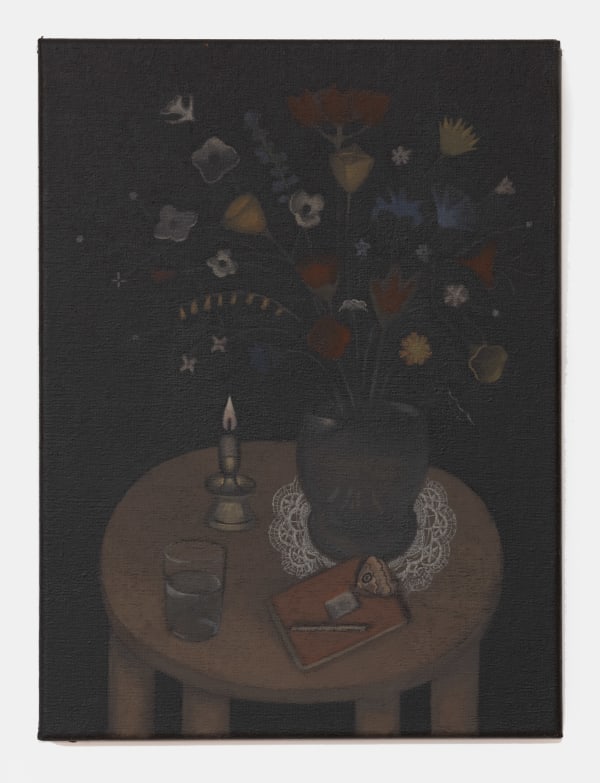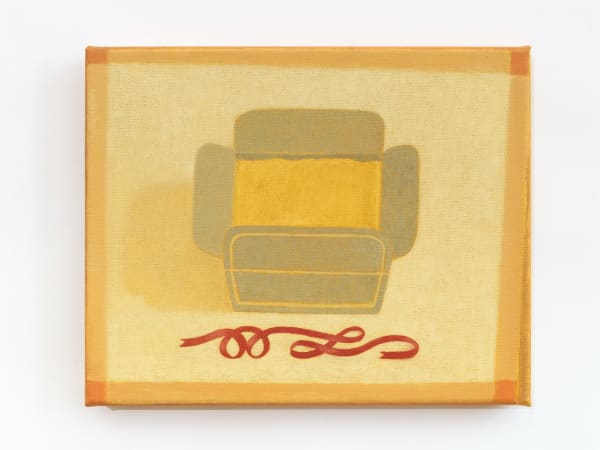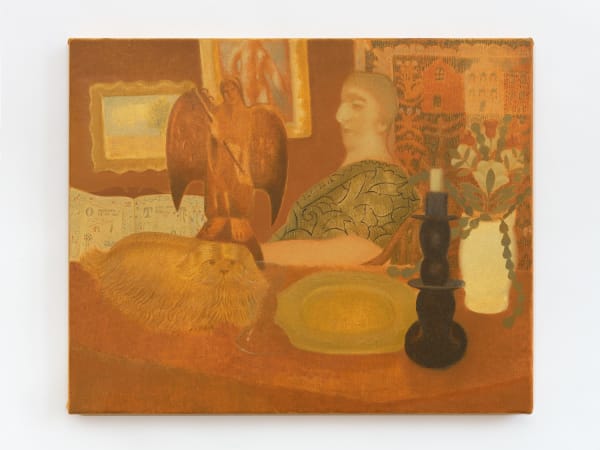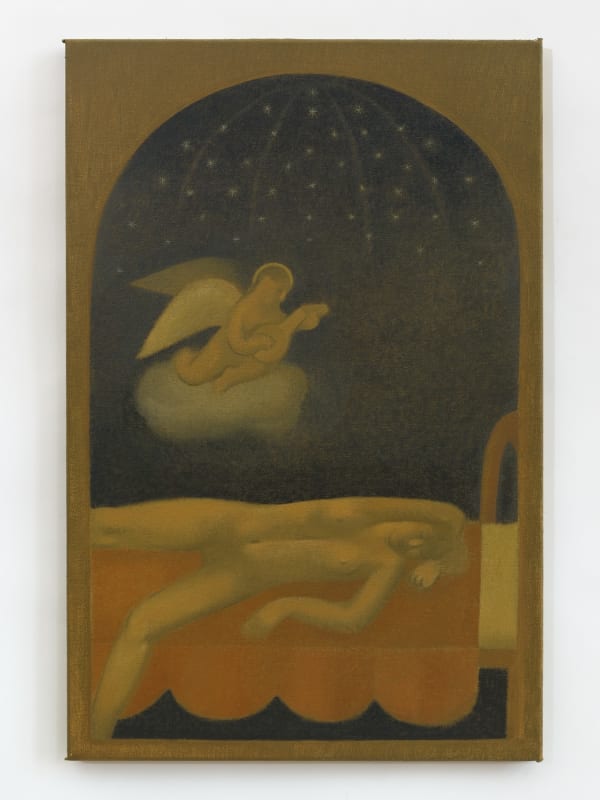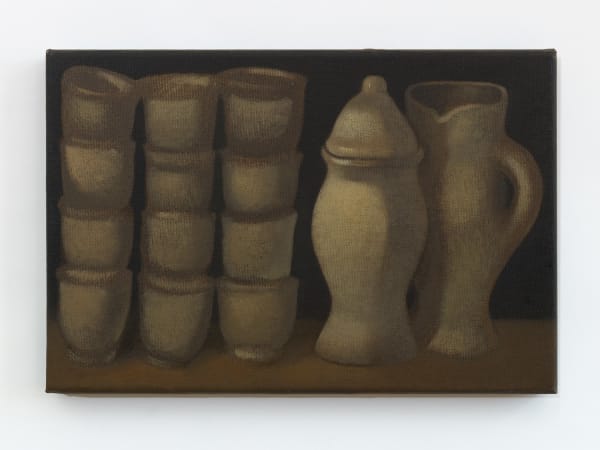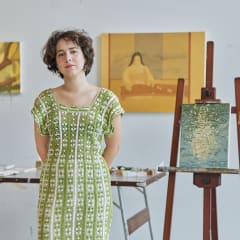O soar das horas Paula Siebra
Past exhibition
Overview
Nieuwe Gentweg 21
8000 Bruges
Belgium
In the hustle of everyday life, one will have to pay attention, yet when it is quiet, their sounds become unmistakable. For centuries, even longer, the bells of Bruges have clocked time, relentlessly partitioning subjective eternities into objectively measurable sections. During medieval times, and even not that long ago, their peal was a reminder to pray the Hours, a spiritual marker to divide the days. Their chime accompanied life and death and everything in between. In few other cities has the ringing of the bells and the sounds of the Belfry’s Carillon remained as omnipresent as in Bruges. One doesn’t even have to listen – their sounds are just there.
It is not as much surprising as it is telling that Paula Siebra has chosen O Soar das Horas – the Chime of Time – as the title for her first solo exhibition in Belgium. The title triggers associations on different levels, like music, poetry, arts, or history; it evokes thoughts on Books of Hours that are among the sources of her inspiration. Most of all, however, the sounds of the bells of Bruges have been omnipresent when the artist worked in her ephemeral studio during her first residency abroad, or when she strolled around curiously through the deserted streets of the city. O Soar das Horas is the stunning result of the extraordinary generosity of supportive patrons, extraordinary artistic talent, and the extraordinary circumstances of our time. It is the result of a temporary arrangement that tries to defy time and thereby becomes timeless.
For the past few months, Paula Siebra has created an artist’s studio and transformed it into a solitary place for art. The softly tinted walls, deprived of all wallpaper and other decorations, recall the warm colors of landscapes of the Brazilian province of Ceará (where Siebra has been raised in the town of Fortaleza); colors that set the tone of her paintings with their stunningly nuanced variety of warm, almost glowing earth tones. When visiting the studio, one encountered paintings, drawings, collages, and discarded sketches in a space that was disconnected from the world and transcended time.
The paintings in this show have been produced in a short but intensely productive period, a period of many new and unexpected impressions. They represent a progressive continuation of previous artistic interests as well as fresh reflections of first-hand encounters with the heritage present in Bruges and other Flemish towns. For the first time, to give but one of many examples, Siebra was able to observe from up and close a painted surface by Jan van Eyck.
All these impressions had their impact. In some of her latest paintings, we encounter experimental qualities that try to come to terms with technical aspects of the Old Masters. This is not surprising, given the fact that Siebra retains control of every aspect of her artistic production, from placing the canvas on the stretchers to preparing her own colors with freshly ground pigments. We recognize attempts to apply tempera on dark grounds as the Italian painters of the Renaissance and the Baroque did. Siebra masters the ancient techniques in order to regain command pictorially. This can be seen in Prateleira dos Fundos or Mesinha de Cabeceira Flamenga. Both of these works seem to have roots in the universal tradition of still-lifes, to which Flemish art made important contributions. We recognize this painting technique in the mysterious, dreamlike Cochilo com anjo tocando alaúde, which feels like the happy reply to the disturbing imagery of Johann Heinrich Füssli’s Nightmare and the pictorial universe of William Blake.
Canal, with its greyish-blue tonality, captures the timeless aspects of the Pittoresque that has fascinated and inspired artists and writers that visited Bruges. It represents a very personal view on the reflections of the city – its architecture and its nature – on the mirror-like surface of the water. It seems to place itself into a tradition that has been defined in pictures by Fernand Khnopff and Henri Le Sidaner or in the texts of Georges Rodenbach.
The artist’s self-portrait at age 22, in its turn, is clearly inspired by the portraits of Hans Memling, which are kept in the nearby Hospital of St. John (Sint-Janshospitaal). This painting reveals Siebra’s preoccupation with more formal aspects of Flemish Primitive art, while O Antiquário, Interior com cadeira, flores e janela and Jarra, maçãs e menina seem to reimagine works by James Ensor, the Flemish Expressionists or Jean Brusselmans.
The reminiscence of Siebra’s painting to artistic tradition seems paramount and embraces artists from Brazil as well as from Europe. Names like Paul Cézanne or Giorgio Morandi inevitably come to mind when looking at some of her still-lifes. One of my favorites is Casal dormindo, an icon of peaceful intimacy that is universal because of its apparently simple visual language – and somehow formally recalls the work of Constantin Brâncusi, who also attempted universality. All these references – real and/or imagined – may be subconscious and even accidental; to dismiss them as eclectic does not only fail to recognize the strong voice of an emerging artist but, more importantly, also ignores that these reminiscences are evocations that give Siebra’s pictorial universe a timeless character.
Paula Siebra’s pictures tell stories that unfold simultaneously, stories of imagination and without words. Her stories transcend reality and settle in an imaginary universe, which is essentially poetic in nature and enchanting. In her artistic process, in which drawing is of greatest importance, words or phrases don’t translate into pictures, nor do pictures transform into words. The image starts to tell its story along with the narrative of its details, of its colors, of its symbols. The story encapsulated in her picture consists of objects that have been found, seen, discarded, imagined, reassembled. What appears to be a spontaneous image is the result of hard labor, of many attempts of rearranging the syntax of each detail into the grammar of the picture. If all fits, the picture speaks. An idea becomes a necessity in the process of its realization. Even if the bell sounds every hour, it is timeless.
– Till-Holger Borchert
8000 Bruges
Belgium
In the hustle of everyday life, one will have to pay attention, yet when it is quiet, their sounds become unmistakable. For centuries, even longer, the bells of Bruges have clocked time, relentlessly partitioning subjective eternities into objectively measurable sections. During medieval times, and even not that long ago, their peal was a reminder to pray the Hours, a spiritual marker to divide the days. Their chime accompanied life and death and everything in between. In few other cities has the ringing of the bells and the sounds of the Belfry’s Carillon remained as omnipresent as in Bruges. One doesn’t even have to listen – their sounds are just there.
It is not as much surprising as it is telling that Paula Siebra has chosen O Soar das Horas – the Chime of Time – as the title for her first solo exhibition in Belgium. The title triggers associations on different levels, like music, poetry, arts, or history; it evokes thoughts on Books of Hours that are among the sources of her inspiration. Most of all, however, the sounds of the bells of Bruges have been omnipresent when the artist worked in her ephemeral studio during her first residency abroad, or when she strolled around curiously through the deserted streets of the city. O Soar das Horas is the stunning result of the extraordinary generosity of supportive patrons, extraordinary artistic talent, and the extraordinary circumstances of our time. It is the result of a temporary arrangement that tries to defy time and thereby becomes timeless.
For the past few months, Paula Siebra has created an artist’s studio and transformed it into a solitary place for art. The softly tinted walls, deprived of all wallpaper and other decorations, recall the warm colors of landscapes of the Brazilian province of Ceará (where Siebra has been raised in the town of Fortaleza); colors that set the tone of her paintings with their stunningly nuanced variety of warm, almost glowing earth tones. When visiting the studio, one encountered paintings, drawings, collages, and discarded sketches in a space that was disconnected from the world and transcended time.
The paintings in this show have been produced in a short but intensely productive period, a period of many new and unexpected impressions. They represent a progressive continuation of previous artistic interests as well as fresh reflections of first-hand encounters with the heritage present in Bruges and other Flemish towns. For the first time, to give but one of many examples, Siebra was able to observe from up and close a painted surface by Jan van Eyck.
All these impressions had their impact. In some of her latest paintings, we encounter experimental qualities that try to come to terms with technical aspects of the Old Masters. This is not surprising, given the fact that Siebra retains control of every aspect of her artistic production, from placing the canvas on the stretchers to preparing her own colors with freshly ground pigments. We recognize attempts to apply tempera on dark grounds as the Italian painters of the Renaissance and the Baroque did. Siebra masters the ancient techniques in order to regain command pictorially. This can be seen in Prateleira dos Fundos or Mesinha de Cabeceira Flamenga. Both of these works seem to have roots in the universal tradition of still-lifes, to which Flemish art made important contributions. We recognize this painting technique in the mysterious, dreamlike Cochilo com anjo tocando alaúde, which feels like the happy reply to the disturbing imagery of Johann Heinrich Füssli’s Nightmare and the pictorial universe of William Blake.
Canal, with its greyish-blue tonality, captures the timeless aspects of the Pittoresque that has fascinated and inspired artists and writers that visited Bruges. It represents a very personal view on the reflections of the city – its architecture and its nature – on the mirror-like surface of the water. It seems to place itself into a tradition that has been defined in pictures by Fernand Khnopff and Henri Le Sidaner or in the texts of Georges Rodenbach.
The artist’s self-portrait at age 22, in its turn, is clearly inspired by the portraits of Hans Memling, which are kept in the nearby Hospital of St. John (Sint-Janshospitaal). This painting reveals Siebra’s preoccupation with more formal aspects of Flemish Primitive art, while O Antiquário, Interior com cadeira, flores e janela and Jarra, maçãs e menina seem to reimagine works by James Ensor, the Flemish Expressionists or Jean Brusselmans.
The reminiscence of Siebra’s painting to artistic tradition seems paramount and embraces artists from Brazil as well as from Europe. Names like Paul Cézanne or Giorgio Morandi inevitably come to mind when looking at some of her still-lifes. One of my favorites is Casal dormindo, an icon of peaceful intimacy that is universal because of its apparently simple visual language – and somehow formally recalls the work of Constantin Brâncusi, who also attempted universality. All these references – real and/or imagined – may be subconscious and even accidental; to dismiss them as eclectic does not only fail to recognize the strong voice of an emerging artist but, more importantly, also ignores that these reminiscences are evocations that give Siebra’s pictorial universe a timeless character.
Paula Siebra’s pictures tell stories that unfold simultaneously, stories of imagination and without words. Her stories transcend reality and settle in an imaginary universe, which is essentially poetic in nature and enchanting. In her artistic process, in which drawing is of greatest importance, words or phrases don’t translate into pictures, nor do pictures transform into words. The image starts to tell its story along with the narrative of its details, of its colors, of its symbols. The story encapsulated in her picture consists of objects that have been found, seen, discarded, imagined, reassembled. What appears to be a spontaneous image is the result of hard labor, of many attempts of rearranging the syntax of each detail into the grammar of the picture. If all fits, the picture speaks. An idea becomes a necessity in the process of its realization. Even if the bell sounds every hour, it is timeless.
– Till-Holger Borchert
Works
-
 Paula Siebra, Mesinha de Cabeceira Flamenga, 2021
Paula Siebra, Mesinha de Cabeceira Flamenga, 2021 -
 Paula Siebra, Casal dormindo, 2021
Paula Siebra, Casal dormindo, 2021 -
 Paula Siebra, Menestrel, 2021
Paula Siebra, Menestrel, 2021 -
 Paula Siebra, A Costureira, 2021
Paula Siebra, A Costureira, 2021 -
 Paula Siebra, Caixa de chocolates, 2021
Paula Siebra, Caixa de chocolates, 2021 -
 Paula Siebra, Paisagem Belga, 2021
Paula Siebra, Paisagem Belga, 2021 -
 Paula Siebra, O antiquário, 2021
Paula Siebra, O antiquário, 2021 -
 Paula Siebra, Louça de Banho, 2021
Paula Siebra, Louça de Banho, 2021 -
 Paula Siebra, Café da Manhã do Poeta, 2021
Paula Siebra, Café da Manhã do Poeta, 2021 -
 Paula Siebra, Vista do terraço, 2021
Paula Siebra, Vista do terraço, 2021 -
 Paula Siebra, Numismática acidental, 2021
Paula Siebra, Numismática acidental, 2021 -
 Paula Siebra, Interior com cadeira, flores e janela, 2021
Paula Siebra, Interior com cadeira, flores e janela, 2021 -
 Paula Siebra, Cristaleira, 2021
Paula Siebra, Cristaleira, 2021 -
 Paula Siebra, Jarra, maçãs e menina, 2021
Paula Siebra, Jarra, maçãs e menina, 2021 -
 Paula Siebra, Cochilo com anjo tocando alaúde, 2021
Paula Siebra, Cochilo com anjo tocando alaúde, 2021 -
 Paula Siebra, Autorretrato aos 22 anos, 2021
Paula Siebra, Autorretrato aos 22 anos, 2021 -
 Paula Siebra, Oferenda, 2021
Paula Siebra, Oferenda, 2021 -
 Paula Siebra, Prateleira dos Fundos, 2021
Paula Siebra, Prateleira dos Fundos, 2021 -
 Paula Siebra, Mesa de jantar antes do jantar, 2021
Paula Siebra, Mesa de jantar antes do jantar, 2021 -
 Paula Siebra, Cochilo com anjo trazendo lençol, 2021
Paula Siebra, Cochilo com anjo trazendo lençol, 2021 -
 Paula Siebra, Canal, 2021
Paula Siebra, Canal, 2021
Installation Views

